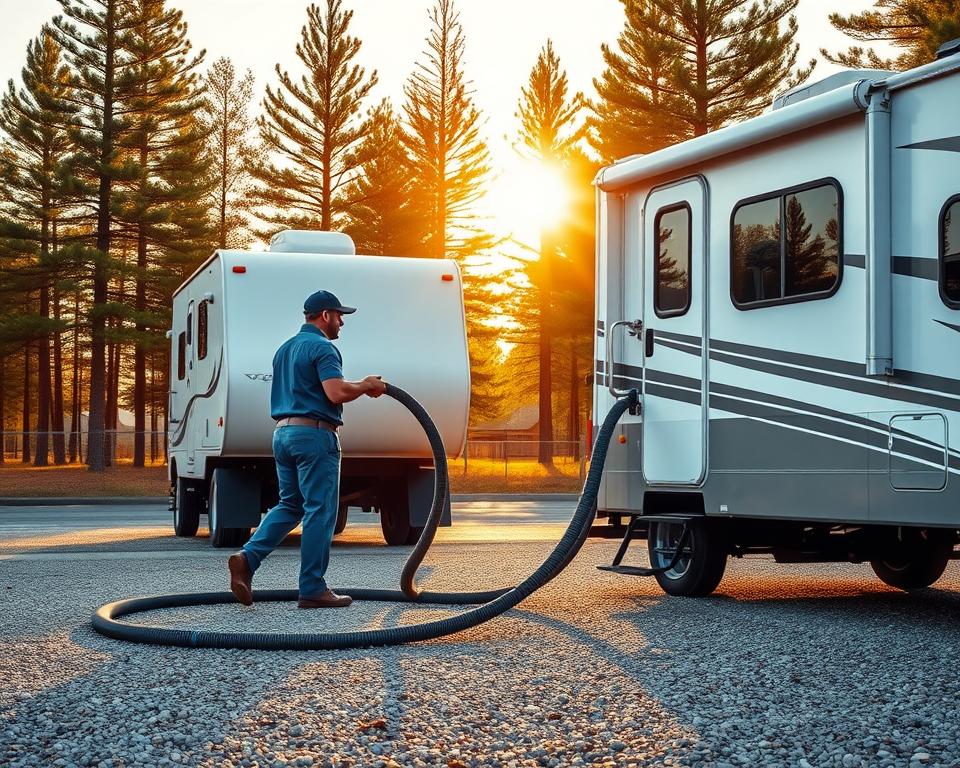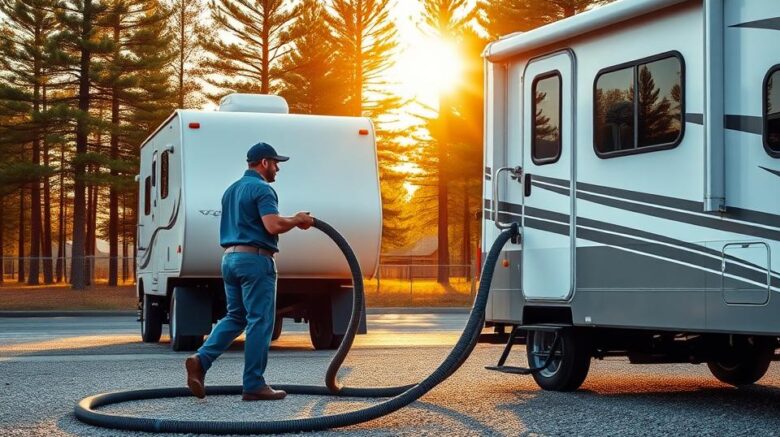RV Sewage Tank Pumping: Key Upkeep Guidelines
Imagine what happens when you ignore your RV’s sewer setup. Many RV owners find the idea of septic tank pumping daunting. However, recognizing the need for regular servicing is crucial. These steps preserve your camping joy and avoid expensive repairs. Learning proper waste disposal is key to your septic health. Here are key pointers on pump for RV holding tank with upkeep advice to ensure your system operates flawlessly.
Getting to Know Your RV’s Waste Setup
All RVs come with a built-in waste management system. The system comprises a black water tank (toilet), a gray water tank (sinks/showers), and a fresh water tank. Knowing these components prevents clogs and ensures efficient cleaning.
A series of drain lines and vent pipes balance waste flow and airflow. A good grasp prevents clogs and nasty odors. It’s the foundation of a smooth camping experience.
Maintaining clear, working tanks requires routine effort. Frequently checking tank levels and emptying on time preserves comfort. Proper upkeep extends tank life and enhances every journey.
Why Routine Tank Pumping Matters
Frequent tank pumping keeps your system working and clean. Leftover solids lead to smells and clogs, spoiling your trip. Overfilled tanks risk ugly overflows. These incidents mar your travel enjoyment.
Skipping pump-outs leads to pricey repairs. Damage from neglect can shorten component lifespan. Regular pumping ensures seamless operation. It prevents unwelcome surprises and roadside emergencies.
Proactive servicing stops clogs. Investing in pump-outs shows you care about your RV. It greatly improves your travel experience. By sticking to a dump schedule, you’ll relish the outdoors worry-free.
Finding the Right Dump Frequency
Timing your tank dumps depends on several variables. Common guidance suggests a 3–5-day window. Still, it varies with tank size and occupancy. Knowing when to pump is vital for managing RV wastewater.
Dump the black tank at about two-thirds capacity. It ensures good drainage and cuts down on odors. Ignoring it can cause backups and unpleasant odors.
Many elements can affect how often you pump:
- Number of people on board
- Length of stay
- Type of waste generated
- Tank capacity
Scheduling prevents on-the-road crises. Remember portable toilet service schedules. Knowing your patterns predicts when to dump.
| Usage Scenario | Pumping Frequency |
|---|---|
| Short Trip, Two Campers | Every 3–4 days |
| Long Stay, Four to Six Occupants | Every 2–3 days |
| Seasonal Use, Two to Four Campers | Weekly or Bi-Weekly |
Monitor fill levels and usage patterns. Staying attentive guarantees a pleasant trip.

Proper Tank Dumping Techniques
Correct dumping preserves system health and prevents issues. Begin with the black tank to avoid cross-contamination. This prevents dirty water from fouling the clean.
Using a high-quality hose minimizes leaks and ensures smooth dumping. Secure all fittings firmly to avoid leaks. After emptying, flush the black tank with plenty of water. This removes residue and preps the tank for next time.
Scout dump spots along your route. This preparation streamlines your dump routine.
To summarize, use these steps:
- Empty the black water tank first.
- Use a top-quality sewer hose.
- Flush the black tank thoroughly after emptying.
- Plan your dump station locations.
These tips refine your waste disposal process.
How to Care for Your Black and Gray Tanks
Knowing proper tank use and maintenance is crucial. Maintain a bit of water in the black tank to aid waste decomposition.
Don’t flush wipes, feminine products, or paper towels. Always use RV-safe toilet paper to prevent clogs. Inspect tanks often to catch problems early.
Occasional treatments boost system performance. They introduce microbes that digest solids effectively. Such measures keep your tanks operating at their best.
- Check for leaks and damage often.
- Apply RV-specific chemical treatments.
- Keep vents clear to avoid odors.
Following these rules protects your septic setup. You’ll enjoy more worry-free trips.
How to Pump Efficiently
Successful pumping requires precision and a clear procedure. Proper disposal prevents issues—only dump at approved stations. Know your tank’s capacity to avoid overflows.
Monitoring levels guides your dump schedule. This extends tank life and enhances trip comfort. A planned maintenance routine keeps everything running smoothly.
Flush well after every emptying. It ensures each dump is cleaner than the last. By applying these strategies, you’ll maintain your RV’s condition and comfort.
Common Mistakes to Avoid When Maintaining Your RV Septic System
Upkeep prevents trip interruptions. Not using enough water in the black tank leads to buildup. Proper flushing dissolves waste better.
Flushing inappropriate items blocks pipes. Only biodegradable RV-safe items belong in the black tank. Such mistakes can damage plumbing and inflate repair bills.
Keep the black tank valve closed until ready to dump. Premature opening prevents a full flush. This ensures solids clear on each dump.
Awareness of these errors boosts system longevity. Steering clear of these mistakes ensures durable performance.
When to Call in Professional RV Waste Disposal Services
Knowing when to hire pros preserves system health. Lingering smells can mean serious tank problems. Slow drains point to potential clogs or buildup.
Waste spillage near dump sites signals trouble. It often calls for a deep professional clean. Experts use specialized tools to clear stubborn clogs.
Routine professional inspections catch hidden issues early. Early intervention avoids expensive failures. Hiring qualified technicians saves time and money long term.
Ongoing Septic Care Tips
Long-term strategies sustain wastewater efficiency. Regular pumping boosts system life and function. Routine rinses clear residue and stave off expensive breakdowns.
Implementing clean cycles safeguards tank health. Inspecting connections stops leaks before they spread. Choosing eco-friendly treatments avoids damage.
Keep these habits in mind:
- Stick to a pump-out timetable.
- Rinse often to remove solids.
- Sanitize twice a year.
- Inspect parts frequently for wear and tear.
Investing in prevention brings peace of mind. Routine service lets you focus on the scenery, not your sewer.
Final Thoughts
Good septic care ensures enjoyable trips. Knowing system function and cleaning steps stops issues. Routine black tank dumping boosts performance. This makes your journey more comfortable.
By regularly checking and properly caring for your septic setup, you’ll ensure worry-free travel. Dependable sewage service backs every adventure. These routines prime your rig for future rides. So you can focus on making memories, not dealing with tanks.
